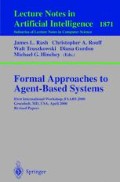Abstract
The panel on Empirical versus Formal Methods was highly thought-provoking. The panel began with 10-minute presentations by the panel members. The first speaker was Doug Smith from Kestrel Institute. The main thrust of Smith’s presentation was that formal methods enable run-time matching of agent services and requirements. In particular, if agent services and requirements are formally specified, then it is possible to automate the matchmaking process. Smith’s presentation was followed by Henry Hexmoor, from the University of North Dakota. Hexmoor emphasized the need for a synergistic relationship between empirical and formal approaches. By using the concept of agent autonomy as a common theme, Hexmoor gave examples of how the two approaches can complement each other in the context of various autonomy schemes. John Rushby, from Stanford Research Institute, was the next speaker. Rushby began by stressing the importance of formal methods as a means of system engineering. A mathematical model enables people to provide behavioral assurances about their system; such assurances are essential for many applications. Rushby then stated that if we design an agent as a formal method (i.e., deduction on a model) then the agent may not require external verification. Rob Axtell, from Brookings Institute, presented his view next. Axtell cautioned us to be careful in our use of formal approaches. He cited examples of potential pitfalls. The last panel member was Nenad Ivezic, from the National Institute for Standards and Technology.
Access this chapter
Tax calculation will be finalised at checkout
Purchases are for personal use only
Preview
Unable to display preview. Download preview PDF.
References
Cohen, P. R. & Levesque, H. J. (1990). Persistence, Intention, and Commitment. Cambridge, MA: MIT Press, Cambridge, MA.
Tambe, M. (1997). Towards flexible teamwork. Journal of Artificial Intelligence Research 7, 83–124.
References
Axtell, R., Epstein, J., & Young, H. (2001). Emergence of Classes in an Multi-Agent Bargaining Model. In S. Durlauf and H. Young (Eds.), Social Dynamics. MIT Press: Cambridge, Mass.
Young, H. (1993). An Evolutionary Model of Bargaining. Journal of Economic Theory 59(1), 145–168.
References
Barbacci, M., Klein, M., Longstaff, T., & Weinstock, C. (1995). Quality Attributes (CMU/SEI-95-TR-21, ADA307888). Pittsburgh, PA: Software Engineering Institute, Carnegie Mellon University.
Brenner, W., Zarnekow, R,., & Wittig, H. (1998). Intelligent Software Agents, Foundations and Applications.;Berlin, Germany: Springer-Verlag.
Hayden, S. C., Carrick, C., & Yang, Q. (1999). Architectural Design Patterns for Multi-Agent Coordination. In Proceedings of the International Conference on Agent Systems. (Agents’99). Seattle, WA.
Klein, M. & Kasman, R. (1999). Attribute-Based Architectural Styles (CMU/SEI-99-TR-022). Pittsburgh, PA: Software Engineering Institute, Carnegie Mellon University.
Woods, S. G. & Barbacci, M.R. (1999) Architectural Evaluation of Collaborative Agent-Based Systems (CMU/SEI-99-TR-025) Pittsburgh, PA: Software Engineering Institute, Carnegie Mellon University.
Author information
Authors and Affiliations
Editor information
Editors and Affiliations
Rights and permissions
Copyright information
© 2001 Springer-Verlag Berlin Heidelberg
About this paper
Cite this paper
Gordon, D. (2001). Panel Discussion: “Empirical Versus Formal Methods”. In: Rash, J.L., Truszkowski, W., Hinchey, M.G., Rouff, C.A., Gordon, D. (eds) Formal Approaches to Agent-Based Systems. FAABS 2000. Lecture Notes in Computer Science(), vol 1871. Springer, Berlin, Heidelberg. https://doi.org/10.1007/3-540-45484-5_36
Download citation
DOI: https://doi.org/10.1007/3-540-45484-5_36
Published:
Publisher Name: Springer, Berlin, Heidelberg
Print ISBN: 978-3-540-42716-2
Online ISBN: 978-3-540-45484-7
eBook Packages: Springer Book Archive

